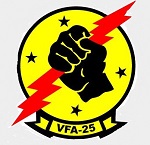Hobby Master HA5123 US Navy Boeing F/A-18E Super Hornet Strike Fighter - VFA-25 "Fist of the Fleet", USS Abraham Lincoln (CVN-72) (1:72 Scale)
"Bigger, Higher, Faster, Farther."
- Thinking within the US Air Force during the late 1970s
 The Boeing F/A-18E and F/A-18F Super Hornet are twin-engine carrier-capable multirole fighter aircraft variants based on the McDonnell Douglas F/A-18 Hornet. The F/A-18E single-seat and F/A-18F tandem-seat variants are larger and more advanced derivatives of the F/A-18C and D Hornet. The Super Hornet has an internal 20 mm M61 rotary cannon and can carry air-to-air missiles and air-to-surface weapons. Additional fuel can be carried in up to five external fuel tanks and the aircraft can be configured as an airborne tanker by adding an external air refueling system.
The Boeing F/A-18E and F/A-18F Super Hornet are twin-engine carrier-capable multirole fighter aircraft variants based on the McDonnell Douglas F/A-18 Hornet. The F/A-18E single-seat and F/A-18F tandem-seat variants are larger and more advanced derivatives of the F/A-18C and D Hornet. The Super Hornet has an internal 20 mm M61 rotary cannon and can carry air-to-air missiles and air-to-surface weapons. Additional fuel can be carried in up to five external fuel tanks and the aircraft can be configured as an airborne tanker by adding an external air refueling system.
Designed and initially produced by McDonnell Douglas, the Super Hornet first flew in 1995. Full-rate production began in September 1997, after the merger of McDonnell Douglas and Boeing the previous month. The Super Hornet entered service with the United States Navy in 1999, replacing the Grumman F-14 Tomcat, which was retired in 2006; the Super Hornet serves alongside the original Hornet. The Royal Australian Air Force (RAAF), which has operated the F/A-18A as its main fighter since 1984, ordered the F/A-18F in 2007 to replace its aging F-111C fleet. RAAF Super Hornets entered service in December 2010.
Pictured here is a gorgeous 1:72 scale diecast replica of a United States Navy F/A-18E Super Hornet strike fighter that was assigned to VFA-25 "Fist of the Fleet" then embarked upon the USS Abraham Lincoln (CVN-72).
Sold Out!
Dimensions:
Wingspan: 7-1/2-inches
Length: 9-inches
Release Date: December 2021
 Historical Account: "Fist of the Fleet" - The Fist of the Fleet was originally commissioned Torpedo Squadron 17 (VT-17) in 1943, and fought during World War II with TBF Avenger and SB2C Helldiver attack bombers.
Historical Account: "Fist of the Fleet" - The Fist of the Fleet was originally commissioned Torpedo Squadron 17 (VT-17) in 1943, and fought during World War II with TBF Avenger and SB2C Helldiver attack bombers.
Following WWII, the squadron was re-designated as VA-6B, then again as VA-65 in December 1947. This coincided with the squadron's transition to the plane it would fly for the next 21 years, the A-1 Skyraider, affectionately nicknamed the "Spad." The squadron sailed aboard the USS Coral Sea on its maiden voyage in early 1948.
The outbreak of hostilities with Korea saw the squadron transferred to NAS Moffett Field. Then in 1950, the squadron deployed to Korean waters aboard the USS Boxer, logging 1,645 combat missions.
In 1959, the squadron was re-designated VA-25. In 1962, the squadron moved to its current home, the newly-completed NAS Lemoore.
From 1965 through 1968, the squadron made three deployments to Southeast Asia, still flying the A-1. During this period, Fist pilots flew over 3,000 combat missions, dropping more than 10 millions pounds of ordnance on enemy targets. On June 20th, 1965, a division of "Spads" were attacked by a section of Vietnamese MiG-17's deep in North Vietnam - the Fists successfully scored a guns kill against one of the jet-powered fighters.
When the Fists turned in their A-1 "Spads" in 1968, it was the last tactical propeller driven squadron in the Navy. The squadron next obtained the A-7 Corsair II, with which it again deployed to Southeast Asia after only four months of training, aboard the USS Ticonderoga. It was during this cruise that the Fists set a record - in 33 flying days, Fist pilots flew 1,650 sorties in combat. During this period, each squadron pilot averaged over 92 hours in the air.





![Royal Navy Ark Royal Class Aircraft Carrier - HMS Ark Royal (91), Battle of the Atlantic, 1941 [Full Hull Version] (1:700 Scale)](http://cdn4.volusion.store/qh9e9-jdqv9/v/vspfiles/photos/FOV861009A-1.jpg?v-cache=1740197136)



